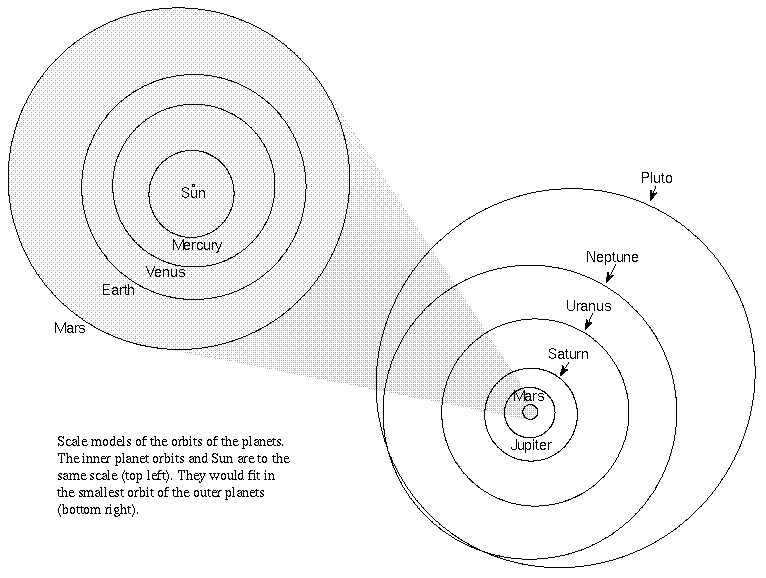
Hello, explorer! You are about to start a journey that will take you to the farthest reaches of space and the innermost depths of matter and from the earliest beginning of time to the future billions of years from now. Introductory astronomy classes have the daunting task of introducing students to the wonders of the entire universe in one short course, often just one semester or one quarter long. Though the places and events you will encounter will sometimes be mind-boggling, I hope you will find it such a fascinating experience that you will want to learn more about those places in another course or in your own free time in the library or in your backyard with binoculars or telescope (or even better, at star parties on a mountain far from the city lights with your local astronomy club).
The first part of this chapter takes you on a tour of the universe in space and time to give you some context---``set the stage and introduce the characters'', some familiar and others quite obscure but still vital to the play. It is like a travel brochure you read before your vacation trip. One word of warning: a lot of numbers and facts are presented in the first section but do not try to memorize them. What is important is to get a sense of the relative scale of things.
In grade school you probably memorized a lot of facts about the planets and stars and when you were older you wondered, ``but how do they know that?'' In the following chapters you will learn how astronomers measure the distances, sizes, and ages of these objects and determine what they are like and what makes them appear the way they do. This textbook emphasizes the techniques and process astronomers use to find out about the universe around us and the unifying principles operating ``behind the scenes''. Facts will be given as examples of what is found when those techniques are used or as examples of a particular effect of a physical principle in operation.
The second part of the chapter presents a brief description of the philosophy and method of science and the role astronomy plays in our attempts to understand the universe scientifically. At the end is a discussion of the non-science often confused with astronomy called astrology. Vocabulary terms in the text are set in boldface to help you find them.
You probably already know that the universe is big but most people do not realize how B I G it really is. Many astronomy classes start off with a tour of the universe based on the excellent short film called Powers of Ten by Charles and Ray Eames. The film starts with a man and woman in a city park and then expands the field of view by ten times every ten seconds until it reaches the bounds of the observable universe. After zooming back to the man and woman in the park, the field of view is reduced by ten times every ten seconds until one proton in a carbon atom in the man's hand fills the screen. The film is longer than one might first expect because of all of those powers of ten that must be counted to include all of the things astronomy covers.
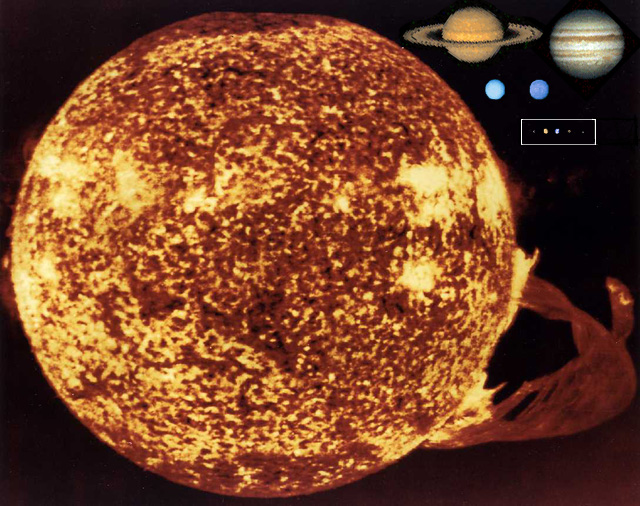
For our scale model, let us use a yellow mini-basketball about 16.51 centimeters (6.5 inches) across to represent the Sun and then pace out how far the tiny planets would be in this scale model. Since the real Sun is 1,392,000 kilometers (865,000 miles) across, the scale model has all of the planets and distances reduced by an amount equal to (139,200,000,000 / 16.51) = 8,431,254,000 times. The largest planet, Jupiter, would be only 1.7 centimeters across (a dime) and about 92.3 meters away. Our little Earth (a grain of sand) would be closer: ``only'' 17.7 meters (about 18 big steps) away. Our Sun is much larger than the planets, and, yet, it is just a typical star! Here is a scaled model of our solar system:
| Object | Real Diameter (km) | Real Distance (million km) | Scaled Size (cm) | Scaled Distance (m) |
|---|---|---|---|---|
| Sun | 1,392,000 | |
16.51 | |
| Mercury | 4880 | 57.910 | 0.058 (tiny! grain of sand) | 6.9 (7 big steps) |
| Venus | 12,104 | 108.16 | 0.14 (grain of sand) | 12.8 (13 big steps) |
| Earth | 12,742 | 149.6 | 0.15 (grain of sand) | 17.7 (18 big steps) |
| Mars | 6780 | 228.0 | 0.08 (almost 1 mm) | 27.0 (27 big steps) |
| Jupiter | 139,822 | 778.4 | 1.7 (a dime) | 92.3 (92 big steps) |
| Saturn | 116,464 | 1,427.0 | 1.4 (a button) | 169.3 (169 big steps) |
| Uranus | 50,724 | 2,869.6 | 0.6 (button snap) | 340.4 (340 big steps) |
| Neptune | 49,248 | 4,496.6 | 0.6 (button snap) | 533.3 (533 big steps) |
| Pluto | 2274 | 5,913.5 | 0.03 (small piece of dust) | 701.4 (701 big steps) |
| Oort Cloud | |
11,200,000 | |
1,328,400 (1,328 km) |
| Proxima Centauri | 375,840 | 40,493,000 | 4.5 (handball) | 4,802,700 (4,803 km) |
I will usually use the metric system in this text. This system is used by every major country in the world except the United States. The United States will eventually adopt this system. Readers in the U.S. can multiply the kilometer numbers by 0.6 to get the number of miles and multiply the centimeter numbers by 0.4 to get the number of inches. Here is a picture of the planet orbits to help you visualize the vast scales of just the solar system.

The Oort Cloud is a huge spherical cloud of trillions of comets surrounding the Sun that is about 7.5 to 15 trillion kilometers across. In our scale model, the middle of the Oort Cloud would be about the distance between Los Angeles and Denver. Proxima Centauri is the closest star to us outside of the solar system (remember that the Sun is a star too!). Proxima Centauri would be from Los Angeles to beyond the tip of the state of Maine on this scale model (from Los Angeles to New Glasgow, Nova Scotia to be more precise!). In our fastest rocket ships (neglecting the Sun's gravity) it would take almost 70,000 years to reach Proxima Centauri!
Instead of using ridiculously small units like kilometers, astronomers use much larger distance units like an astronomical unit to describe distances between the planets and a light year to describe distances between the stars. An astronomical unit = the average distance between the Earth and the Sun, or about 149.6 million kilometers. For example, Jupiter is (778.4 million km)/(149.6 million km) = 5.203 astronomical units from the Sun. A light year is how far light will travel in one year. The distance D something travels in a given time interval t is found by multiplying the speed v by the time interval. In compact math notation this is: D = v×t. You can find out how many kilometers a light year is by multiplying the speed of light by a time interval of one year:
1 light year = (299,800 kilometers/second) × (31,560,000 seconds/year) = 9,461,000,000,000 kilometers (9.461 trillion kilometers---several tens of thousands of times larger than even the astronomical unit!).
The nearest star is about 4.3 light years away which means that it takes light 4.3 years to travel from Proxima Centauri to Earth. The rest of the stars are further away than that! The speed of light is the fastest speed possible for anything in the universe to travel despite what you may see in science fiction movies or books. It is because of the H-U-G-E distances and l-o-n-g times it would take extraterrestrial spacecraft to travel to the Earth that many astronomers are skeptical about extraterrestrial beings abducting humans.
The Sun is one star among over 200 billion stars gravitationally bound together to make the Milky Way Galaxy. A galaxy is a very large cluster of billions of stars held together by the force of their mutual gravity on each other. That definition is a loaded one that will be unpacked and examined in more detail in later chapters, but for now let us continue on our brief tour of the universe. The Milky Way is a flat galaxy shaped like a pancake with a bulge in the center. Stars and gas are clumped in spiral arms in the flat disk part of the Galaxy. Many stars are also found in between the spiral arms. Our solar system is in one of the spiral arms of the Milky Way and is about 26,000 light years from the center of the galaxy. The entire Milky Way is about 100,000 light years across. In our scaled model with the Sun 16.51 centimeters across, the Milky Way would be about 112 million kilometers across or about 38% of the size of the Earth's orbit around the Sun. Recall that Pluto's orbit is only 1.4 kilometers across on this scale---the Galaxy is MUCH larger than our solar system! Here is an artist's view of our galaxy with the Sun's position marked (note that our entire solar system would be smaller than the smallest dot visible in the picture!):
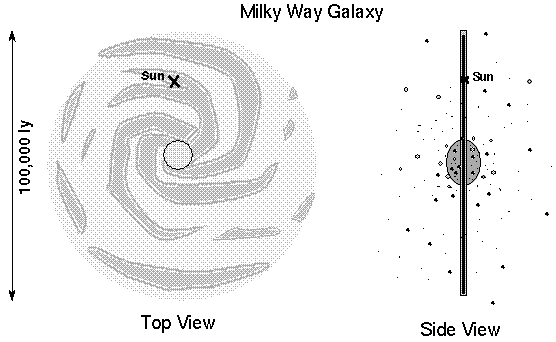
Let's reduce our scale model even more so that our galaxy is the size of the mini-basketball. The closest other galaxy is a small irregularly-shaped one about 13 centimeters away from the Sun toward the direction of the Milky Way's center. It is about the size of a cooked, fat breakfast sausage link in our scale model. Appropriately, the Milky Way is in the process of gobbling up this galaxy. Two famous satellite galaxies of the Milky Way called the Large Magellanic Cloud and Small Magellanic Cloud are about 30 centimeters and 35 centimeters away, respectively. The Large Magellanic Cloud is about the size of a tennis ball and the Small Magellanic Cloud is about the size of a ping pong ball. The Andromeda Galaxy is the closest large galaxy to the Milky Way: a ball 19 centimeters in diameter (a volleyball) about 4.8 meters away. The Milky Way and the Andromeda Galaxy are at either end of a group of about 30 galaxies gravitationally bound together in the Local Group. The Local Group can be roughly divided into two clumps with each clump having a large spiral in it: the Milky Way and the Andromeda Galaxy. Here are three views of the Local Group, each viewed from a position 90 degrees different from the rest. The Milky Way is the large dot at the intersection of the x,y,z axes and the Andromeda Galaxy is the other large dot.
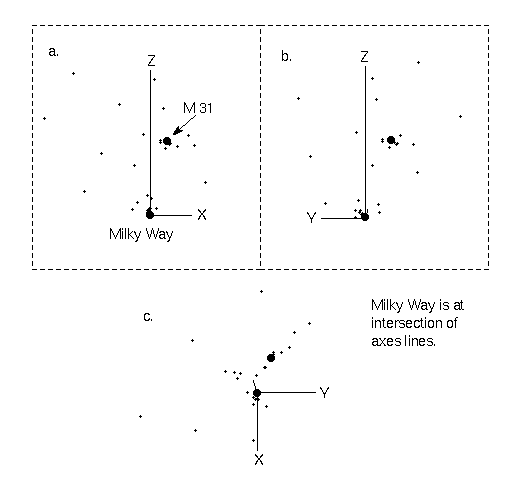
The closest large cluster of galaxies is called the Virgo cluster (toward the direction of the Virgo constellation). The Virgo cluster has over 1000 galaxies in it and is roughly 50 meters away in our scale model. Notice that compared to their size, the galaxies are relatively close to one another. Stars inside a galaxy are relatively very far apart from one another compared to the sizes of the stars. You will see that the relative closeness of the galaxies to each other has a significant effect on the development of galaxies.
The Local Group and Virgo cluster are part of a larger long, narrow group called the Local SuperCluster, sometimes called the Virgo Supercluster since the Virgo cluster is close to the middle. The Local Group is close to one edge of the Local SuperCluster. In our scale model with the Milky Way the size of a mini-basketball, the Local Supercluster is about 190 meters long and the entire observable universe is about 49.5 kilometers in diameter.
| Origin of the Universe--Jan. 1 | Origin of our galaxy--Jan 24 |
| Solar system origin--Sept. 9 | Earth Solidifies--Sept. 14 |
| Life on Earth--Sept. 30 | Sexual reproduction advent--Nov. 25 |
| Oxygen atmosphere--Dec. 1 | Cambrian explosion (600 mil years ago when most complex organisms appear, fish, trilobites)--Dec. 17 |
| Land plants & insects--Dec. 19, 20 | First amphibians--Dec. 22 |
| First reptiles & trees--Dec. 23 | First dinosaurs--Dec. 25 |
| KT impact, mammal age, birds--10:00 AM Dec. 30 | First primates--Dec. 30 |
| Australopithicenes (Lucy, etc.)--10:00 PM Dec. 31 | Homo habilis--11:25 PM Dec. 31 |
| Homo erectus--11:40 PM Dec. 31 | Early Homo sapiens--11:25 PM Dec. 31 |
| Neanderthal man--11:57 PM Dec. 31 | Cro-Magnon man--11:58:38 PM |
| Homo sapiens sapiens--11:58:57 PM Dec. 31 | Human history--11:59:39 PM |
| Ancient Greeks to now--last five seconds | Average human life span--0.15 seconds |
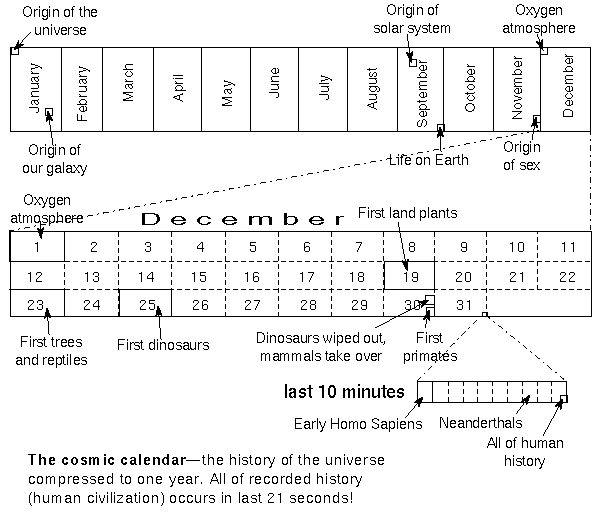
It is rather surprising that we have been able to discover so much about the long term evolution of the universe and the things in it, especially when you consider that we have only been seriously observing the universe for about 100 years, which is only a very slight fraction of the universe's lifetime. About 100 years ago is when photography was first used in astronomy, making truly systematic observation programs possible. How can astronomers say that the Sun will go through a red giant phase in about 5 billion years from now with confidence? Is it hubris to confidently talk about the Earth's formation process 4.6 billion years ago?
To give you an idea of the difficulties in studying long timespans consider this analogy: An alien comes to Earth to search for life and to understand how it evolved. ET has a camera and has just 15 seconds to take as many photographs as possible. Fifteen seconds is the same proportion of a human lifetime as the 100 years is to the universe's age (15 seconds/human lifetime = 100 years/universe age). ET returns home and her colleagues try to understand Earth from this 15 second period of snapshots. They won't see any important evolutionary changes. How will they determine the dominant life form? They could use a variety of criteria: 1) Size: leads them to choose whales or elephants; 2) Numbers: choose insects; 3) amount of land space controlled by one species: choose automobiles.
Suppose they somehow decide humans are dominant. They now have further problems. There is considerable diversity among the humans (though to ET with 10 tentacles, 200 eyes, and a silicon outer shell, the humans all look alike!). ET and colleagues try to systematically classify the humans. The humans come in a variety of sizes. In a coarse classification scheme, they break the sizes down into small, medium, and large. They also come in variety of optical colors for their outer shell: red, black, brown, yellow, and white. There appears to be 2 separate sexes (ET is both male and female). After some false starts with theories that used hair length and eye color, they are ready to ask themselves, ``Do small, brown, female humans evolve into large, red, male humans?'' ``Do the small stay small and the large stay large?'' ``Why is there a tendency for small humans to be with one or two large humans?'' With the three characteristics [size (3 divisions), color (5 divisions), and sex (2 divisions)], ET has 3×5×2 = 30 different combinations and 30×30 = 900 possible evolutionary schemes to consider! Well, the universe has a lot more characteristics and, therefore, many more combinations to consider!
| astronomical unit | light year |
|---|
Often the evidence for a particular hypothesis is indirect and will actually support other hypotheses as well. The goal is to make an observation that conclusively disproves one or more of the competing theories. Currently unresolvable questions may be resolved later with improved observations using more sophisticated/accurate equipment. Sometimes new equipment shows that previously accepted theories/hypotheses are wrong!
Scientific models and theories must make testable predictions. If an explanation is offered that has no concrete test that could disprove the explanation in principle, it is not a scientific one. This characteristic of scientific explanations is often the distinguishing one between scientific and other types of theories or beliefs (religious, astrological, conventional wisdom, etc.). Do understand that a scientific theory can be incorrect but still be considered a good scientific theory because it makes a testable prediction of what will happen under a given set of observing or analysis circumstances.
Since this is a science textbook, I will focus on the scientific type of explanations. Whether or not you, the reader, chooses to believe what is discussed here is up to you. However, I want you to understand the physical principles discussed here and be able to apply them to various situations. The scientific method for finding scientific truth is discussed in more depth in the scientific method chapter.
In addition you will see later that the light coming from far-away objects in all parts of the universe tells us about the laws of physics (the rules of nature governing how physical things interact with each other) there. Astronomers find that the laws of physics discovered here on the Earth are the same throughout the cosmos. The fact that nature makes nearly an infinite variety of things from the same types of material we have here on the Earth and has those things interact with each other in so many different ways using the same rules we see followed here on the Earth is awe-inspiring.
Now back to the long term evolution side of the coin. We actually have a time machine! Not the H.G. Wells variety or G. Roddenberry's Guardian of Forever but something much simpler due to the large distances and finite speed of light (300,000 kilometers/second!). It takes time for radiation from a celestial object to reach the Earth. Therefore, when you examine an object at a large distance from us, you see it as it was. The farther away the object is, the longer it took the radiation to reach the Earth, and the further back in time you observe it. The Sun is 150 million kilometers from us, so you see the Sun as it was 8-1/3 minutes ago. The farthest object you can see without a telescope is the Andromeda galaxy about 2.8×1019 kilometers from the Earth, so you see it as it was almost 3 million years ago. Recall that a light year is how far light travels in one year (about 9.46×1012 kilometers). Therefore, the Andromeda galaxy is almost 3 million light years away from us. (The speed of light is the key in the relationship between space and time, a fact used by Albert Einstein in developing his Relativity theories that are described in other chapters.
To study the evolution of long-lived objects like stars (with lifetimes of millions to billions of years) or galaxies, astronomers observe the objects of interest at different distances from the Earth so they are seen at different epochs. Therefore, the objects are seen at various different ages or evolutionary stages. Since light from remote objects can take millions to billions of years to reach the Earth, astronomers find out about the laws of physics at different times. What they find is that the universe has used the same laws of physics throughout its 15-billion year lifetime (and presumably will continue using those same rules). Pretty amazing!
While most astrologers were developing ways to predict the future of human events by careful observations of the sky, early astronomers were developing ways to predict the motions of the planets, Sun, and Moon. Most early astronomers were motivated by the idea that if they could accurately predict the motions of the planets then they would be able to accurately predict the future of persons. Astronomy broke away from astrology and became a science when astronomers became more interested in explaining what made the planets move the way they do and not in divining the future and interactions of individuals.
Right away you run into a problem with the zodiac constellations---some are large (like Scorpio or Virgo) and others are small (like Aries and Cancer). Because the rate that the Sun moves along the ecliptic is nearly constant, the Sun spends more time in the large zodiac constellations than in the small ones. It does not matter whether you use the ancient constellation boundaries or the modern boundaries recognized by the International Astronomical Union (though, the IAU boundaries have the Sun spending part of its time in the non-zodiac constellation Ophiuchus!). However, the dates listed in the newspaper for the horoscope signs are all 30 or 31 days long (even for tiny Aries) and the horoscopes do not include the constellation Ophiuchus.
Because of an effect called precession, the zodiac constellations slide westward along the ecliptic, making a complete circuit in about 26,000 years. Since the zodiac signs were named over 2000 years ago, the stars have moved by about 1/12 of the zodiac (about one sign's worth). Your ``sign'' may be one month off! (The different sizes of the constellations prevents me from making a more definite statement.) For example, if your sign is a Sagittarius, then the Sun was actually located in the constellation Scorpio when you were born. Actually, for part of the Sagittarius timeframe, the Sun is in Ophiuchus, so perhaps that is not a good example (what do you think?).
The horoscope includes the position of each planets in the zodiac and where they are with respect to the person on the Earth at the time of his/her birth. Because of this, creating a horoscope is a bit complicated. There are some standard rules (most of which have not changed for thousands of years despite the dramatic improvements in our knowledge of how the planets and stars move), but how much emphasis an astrologer will give to each rule in developing the horoscope, depends on the creativity of the astrologer. This lack of objectivity is one reason why astrologers cannot agree on the right prediction for any given person. Unlike astronomy, astrology does not have clar objective observations of nature (experiments) determine the truth.
Many people read their horoscope in the newspaper not to get a prediction of what will happen to them, but, rather, to get advice on what they should do in the day (in the United States the horoscope columns focus on who to date and how best to gain money). A person who is serious about using astrology to guide their actions should consult several horoscope columns every day to be sure they have the most accurate information. Unfortunately, that person would find out that the horoscopes for him/her are not consistent with one another even though the horoscopes are phrased as vaguely as they are. Astrology is not as systematic as it claims to be.
Many tests comparing the birthdates of national or state leaders have found the birthdates to be randomly distributed among the twelve signs. If astrology could determine a person's future or his/her personality, then the leaders should have birthdates in one or two signs. Other tests on the birthdates of those who re-enlist in the Marines have also found a completely random distribution of birthdates among all of the signs. A recent episode of NOVA (on PBS) showed a researcher testing astrology by giving each person in a college class of astrology believers their own individual authentic horoscope. Not surprisingly, they found some event in their day that fitted their horoscope. The students then gave their horoscope to the person sitting behind them. To their surprise or dismay, the students discovered the substituted horoscopes were just as good! (Yes, the students had birthdays spread throughout the year.) There are numerous cases of twins or triplets having different personalities and life events even though their birth times and places were very close to one another.
Usually, those who seek out astrologers just want some guidance of any kind. If they feel the horoscope interpretation was prepared just for them, then they will find agreement with reality. To test this, Michel Gaugelin (a French researcher) sent a horoscope of a mass murderer to 150 people but told each one that the horoscope was prepared just for him or her. Over ninety percent of them said they could see themselves in that horoscope. If a person is already convinced ahead of time of the validity of something like a horoscope or a psychic's prediction, then he or she will be easily able to use his or her natural problem-solving capabilities and creativity to make sense of the vague, even contradictory statements. The Australian researcher Geoffrey Dean substituted phrases in the horoscopes of 22 people that were opposite of the original phrases in the horoscopes. Ninety-five percent of time they said the horoscope readings applied to them just as well as to the people to whom the original phrases were given. An astrologer relies on her client's ability to create meaning in even random data and to fill in the gaps of incomplete information if some context is given (of if the creative makes up a context himself). The astrologer's predictions will always be ``correct'', not testable as a scientific theory or prediction must be.
| astrology | ecliptic | model |
|---|---|---|
| zodiac |
last updated 24 January 1999
(805) 395-4526
Bakersfield College
Physical Science Dept.
1801 Panorama Drive
Bakersfield, CA 93305-1219